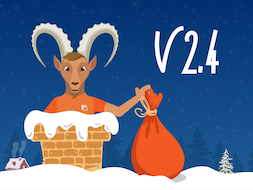Winter Release: eZ Platform v2.4

The holiday season is always an exciting time here at eZ. It marks another release filled with new features and improvements that will benefit our users. The eZ team has been working hard to deliver these cool and exciting features that will improve both the editorial and developer experience on eZ Platform.
And just as a reminder (in case you missed it), this v2.4 release is a fast track release and not a long-term supported (LTS) release. The LTS release for version 2 is expected for later. To learn more about this change, check out this blogpost, eZ Platform v2.4 update.
Now let's dive into each feature.
Using the new Editorial Workflow
The most prominent feature of the eZ Platform Enterprise Edition v2.4 release is the new Editorial Workflow. The Editorial Workflow enables organizations to define processes that the content under creation must follow before being published. This feature can help ensure that the content being produced is high quality and has been reviewed and validated prior to being published, which can be very useful in large enterprises with many contributors as well as in domains which are highly regulated.
The Editorial Workflow is very simple to set up. Developers can easily create a workflow for any type of user, and administrators can then define and assign each user a set of roles and permissions during the process of creating and publishing content.
To learn more about this feature, we recommend reading this blog post: [Sneak Peek] Configuring Editorial Workflows on eZ Platform.
Page Builder updates
As you all may recall, during our v2.2 release, we introduced a faster, better and friendlier Page Builder. The Page Builder was completely rebuilt and received a lot of positive feedback.
However, it was missing few essential blocks: namely, the Rich Text Block and the Form Block. We are happy to announce that both will now be available in v2.4.
Before we jump into more detail about these features, it's important to mention that we also have improved the overall design of the Page Builder. Editors will notice that the page, zones and block placeholders have a much better and usable design. Additionally, moving blocks within the page has been improved and will provide a better user experience.
Moving blocks into defined zones
Edit rich content directly in the page with Rich Text Block
Editors can now insert rich text content directly in the Page Builder using the Rich Text Block. This is based on the regular Online Editor of eZ Platform and includes all its capabilities such as, including images, content embeds, links, styling and custom tags.
The Rich Text Block is a good option when editors would like to create new content that won't be reused anywhere else. In such cases, the Rich Text Block lets editors work way faster.
Also important to understand, the content created using the Rich Text Block will not be stored as a reusable content item in the content repository, hence it not being the best option if you plan on reusing that content later on.
To learn more, we suggest reading this blog post: [Sneak Peek] Creating Content on to the page using Rich Text Block.
Embedding rich text in Rich Text Block
Working quickly with forms in the new Form Block
In the previous release, we introduced a new Form Builder in which users can easily create, manage and reuse forms anywhere on their website.
However, there was no dedicated Page Builder block that editors could use to quickly embed forms into.
In eZ Platform v2.4, we are happy to introduce the Form Block. It allows editors to quickly select existing forms that are stored in their content repository and place them into the page. Editors also have the option to create forms on the fly from the Universal Discovery Widget (UDW).
Embedding forms in Form Block
Improved Online Editor
As mentioned, we've also worked on improving the design and usability of the online editor. The new online editor is lighter in color and not as prominent. Editors will notice that the toolbars size has been reduced and labels have been removed in order to better maximize the space on your screen and ultimately provide a better user experience.
Here is a comparison between the old vs. new online editor design:

Online Editor comparison
Another small, yet much-needed improvement, editors have now the possibility to add links to various images that are embedded in content. We also upgraded custom tags capabilities by allowing users the ability to write rich text directly into a custom tag. Additionally, editors can embed custom tags inside each other if needed.
Improvements to the Admin Interface
An additional improvement that may seem small but provides a great benefit to editors: it's now possible to move and delete content items in bulk. This will reduce the number of clicks for editors.
We have also added an active delete modal window to notify the user when deleting a container with sub-items, that he will also delete the sub-items.
We also improved the search functionality: v2.4 brings a new subtree filter. Editors can now restrict the search to specific parts of the content repository. This is especially useful in multi-site configurations, as editors will be able to search more quickly for various content items. We also improved the design of the search interface to make it more readable and enables editors to increase the number of filters they want to use.
With v2.4, administrators will now be able to translate content types through the admin panel. Furthermore, these content type translations will be automatically showcased according to the preferred language of the browser. We expect this feature to provide a better and more consistent user experience for teams that are located in different countries. For example: If I have a team in France, their admin interface will be in French, and the content types they use will also be labeled in French. This was not the case until now, even if the main language of the system was English.
We have also made some improvements to user permissions in relation to content types presented to the editor when they are creating content. Moving forward, an editor will only see the content types that she/he has the permission to create. This will remove the confusion of thinking that certain buttons are not working when in fact the editor does not have correct permissions to use them.
A few more worthy mentions
There are a few more features that are worth mentioning which could be beneficial for editors and developers. First, we have created a dedicated view for draft lists under the account user menu. This will make drafts more accessible for editors.
Additionally, a majority of users told us that the "load more" button in the sub-items list was slow and not user-friendly. Therefore, we decided to switch to a pagination system. We believe that this will simplify the work for editors. The number of displayed sub-items is now customizable in the user settings.
On another note, developers and system administrators will be able to regenerate the aliases of all content items in the system. This is very useful when deciding, for instance, on a new URL pattern.
Developers may recall that there was an issue with the literal tag when migrating from eZ Publish to eZ Platform. This issue has now been resolved in the migration script for v2.4. Literal tag is now converted to formatted text.
Another surprise we have in store is that administrators will be able to set password requirements for users, to enforce passwords to follow special rules such as "use of upper, lower case characters and at least one special character".
eZ Platform v2.4 also brings a major new feature for developers: the support of GraphQL, for now as an experimental independent package. GraphQL is a query language that exposes a schema over HTTP and allows developers to describe precisely what data they want to get from it.
This will certainly speed up and simplify things for developers on eZ Platform, especially when they want to use it in a decoupled mode or as a headless CMS. Developers will be able to write a unique query to easily retrieve any type of information stored in their content repository.
To learn more about this feature we recommend reading the blog post: [Sneak Peek] Experimental Package for GraphQL Support.
eZ Platform v2.4 is available on ezplatform.com and via composer update. eZ Platform Enterprise Edition v2.4 is available for customers in their support portal. eZ platform Enterprise Edition v2.4 is available as a trial for partners in the partner portal. It is of course also available on eZ Platform Cloud.
To see the full list of eZ Platform v2.4's new features, check out our release notes, as well as the link to the list of changes on Github for open source and the enterprise edition. If you have any questions, please feel free to drop us a comment on https://discuss.ibexa.co/ or reach out to us, too, at productmanagement@ibexa.co
